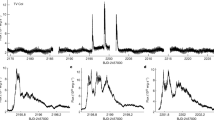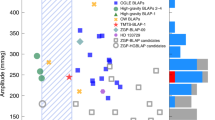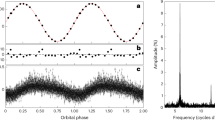Abstract
Accreting white dwarfs are often found in close binary systems with orbital periods ranging from tens of minutes to several hours. In most cases, the accretion process is relatively steady, with significant modulations only occurring on timescales of ~days or longer1,2. Here we report the discovery of abrupt drops in the optical luminosity of the accreting white dwarf binary system TW Pictoris by factors up to 3.5 on timescales as short as 30 minutes. The optical light curve of this binary system obtained by the Transiting Exoplanet Survey Satellite (TESS) clearly displays fast switches between two distinct intensity modes that probably track the changing mass accretion rate onto the white dwarf. In the low mode, the system also displays magnetically gated accretion bursts3,4,5, which implies that a weak magnetic field of the white dwarf truncates the inner disc at the co-rotation radius in this mode. The properties of the mode switching observed in TW Pictoris appear analogous to those observed in transitional millisecond pulsars6,7,8,9,10, where similar transitions occur, although on timescales of ~tens of seconds. Our discovery establishes a previously unrecognized phenomenon in accreting white dwarfs and suggests a tight link to the physics governing magnetic accretion onto neutron stars.
This is a preview of subscription content, access via your institution
Access options
Access Nature and 54 other Nature Portfolio journals
Get Nature+, our best-value online-access subscription
$29.99 / 30 days
cancel any time
Subscribe to this journal
Receive 12 digital issues and online access to articles
$119.00 per year
only $9.92 per issue
Buy this article
- Purchase on Springer Link
- Instant access to full article PDF
Prices may be subject to local taxes which are calculated during checkout

Similar content being viewed by others
Data availability
The data collected by the TESS mission used in this study can be obtained from MAST in reduced and calibrated format (https://mast.stsci.edu/). The ASAS-SN g- and V-band magnitudes can be obtained from the ASAS-SN Sky Patrol webpage (https://asas-sn.osu.edu/). Correspondence and requests for materials should be addressed to S.S. (simone.scaringi@durham.ac.uk).
References
Szkody, P. Insights from multi-wavelength observations during high and low states of non-magnetic CVs. Adv. Space Res. 66, 1090–1096 (2020).
Hameury, J. M. A review of the disc instability model for dwarf novae, soft X-ray transients and related objects. Adv. Space Res. 66, 1004–1024 (2020).
Scaringi, S. et al. Magnetically gated accretion in an accreting ‘non-magnetic’ white dwarf. Nature 552, 210–213 (2017).
Patruno, A., Watts, A., Klein Wolt, M., Wijnands, R. & van der Klis, M. 1 Hz flaring in SAX J1808.4-3658: flow instabilities near the propeller stage. Astrophys. J. 707, 1296–1309 (2009).
Patruno, A. & D’Angelo, C. 1 Hz flaring in the accreting millisecond pulsar NGC 6440 X-2: disk trapping and accretion cycles. Astrophys. J. 771, 8 (2013).
Papitto, A. et al. Swings between rotation and accretion power in a binary millisecond pulsar. Nature 501, 517–520 (2013).
de Martino, D. et al. X-ray follow-ups of XSS J12270-4859: a low-mass X-ray binary with gamma-ray Fermi-LAT association. Astron. Astrophys. 550, 16 (2013).
Linares, M. X-ray states of redback millisecond pulsars. Astrophys. J. 795, 10 (2014).
Ferrigno, C. et al. Hiccup accretion in the swinging pulsar IGR J18245-2452. Astron. Astrophys. 567, 14 (2014).
Bogdanov, S. et al. Coordinated X-ray, ultraviolet, optical, and radio observations of the PSR J1023+0038 system in a low-mass X-ray binary state. Astrophys. J. 806, 23 (2015).
Tuohy, I. R., Buckley, D. A. H., Remillard, R. A., Bradt, H. V. & Schwartz, D. A. Identification of two southern X-ray emitting cataclysmic variables. Astrophys. J. 311, 275–298 (1986).
Norton, A. J., Beardmore, A. P., Retter, A. & Buckley, D. A. H. The nature of TW Pictoris. Mon. Not. R. Astron. Soc. 312, 362–370 (2000).
Aizu, K. X-ray emission region of a white dwarf with accretion. Prog. Theor. Phys. 49, 1184–1194 (1973).
Warner, B. Cataclysmic Variable Stars (Cambridge Univ. Press, 2003).
Patterson, J. & Moulden, M. Rapid oscillations in cataclysmic variables. X. TW Pictoris (= H0534-581). Publ. Astron. Soc. Pac. 105, 689 (1993).
Buckley, D. A. H. & Tuohy, I. R. H0534-581: a new intermediate polar? Astrophys. J. 349, 296 (1990).
Shappee, B. J. et al. The man behind the curtain: X-rays drive the UV through NIR variability in the 2013 active galactic nucleus outburst in NGC 2617. Astrophys. J. 788, 13 (2014).
Kochanek, C. S. et al. The All-Sky Automated Survey for Supernovae (ASAS-SN) light curve server v1.0. Publ. Astron. Soc. Pac. 129, 104502 (2017).
King, A. R. & Cannizzo, J. K. Low states in cataclysmic variables. Astrophys. J. 499, 348–354 (1998).
Littlefield, C. et al. The rise and fall of the king: the correlation between FO Aquarii’s low states and the white dwarf’s spin-down. Astrophys. J. 896, 16 (2020).
D’Angelo, C. R. & Spruit, H. C. Accretion discs trapped near corotation. Mon. Not. R. Astron. Soc. 420, 416–429 (2012).
Hameury, J. M. & Lasota, J. P. VY Sculptoris stars as magnetic cataclysmic variables. Astron. Astrophys. 394, 231–239 (2002).
Shakura, N. I. & Sunyaev, R. A. Black holes in binary systems. Observational appearance. Astron. Astrophys. 500, 33–51 (1973).
Zorotovic, M., Schreiber, M. R. & Gänsicke, B. T. Post common envelope binaries from SDSS. XI. The white dwarf mass distributions of CVs and pre-CVs. Astron. Astrophys. 536, 16 (2011).
Nauenberg, M. Analytic approximations to the mass-radius relation and energy of zero-temperature stars. Astrophys. J. 175, 417 (1972).
King, A. R., Pringle, J. E. & Livio, M. Accretion disc viscosity: how big is alpha? Mon. Not. R. Astron. Soc. 376, 1740–1746 (2007).
Martin, R. G., Nixon, C. J., Pringle, J. E. & Livio, M. On the physical nature of accretion disc viscosity. New Astron. 70, 7–11 (2019).
Shahbaz, T. et al. Evidence for hot clumpy accretion flow in the transitional millisecond pulsar PSR J1023+0038. Mon. Not. R. Astron. Soc. 477, 566–577 (2018).
Papitto, A. et al. Pulsating in unison at optical and X-ray energies: simultaneous high time resolution observations of the transitional millisecond pulsar PSR J1023+0038. Astrophys. J. 882, 20 (2019).
Bogdanov, S. et al. Simultaneous Chandra and VLA observations of the transitional millisecond pulsar PSR J1023+0038: anti-correlated X-ray and radio variability. Astrophys. J. 856, 9 (2018).
Hermsen, W. et al. Synchronous X-ray and radio mode switches: a rapid global transformation of the pulsar magnetosphere. Science 339, 436–439 (2013).
Ricker, G. R. et al. Transiting Exoplanet Survey Satellite (TESS). J. Astron. Telesc. Instrum. Syst. 1, 014003 (2015).
Jenkins, J. M. et al. The TESS science processing operations center. Proc. SPIE 9913, 20 (2016).
Gaia Collaboration et al. Gaia Early Data Release 3. Summary of the contents and survey properties. Astron. Astrophys. 649, 20 (2021).
Meyer, F. & Meyer-Hofmeister, E. Accretion disk evaporation by a coronal siphon flow. Astron. Astrophys. 288, 175–182 (1994).
Scaringi, S. A physical model for the flickering variability in cataclysmic variables. Mon. Not. R. Astron. Soc. 438, 1233–1241 (2014).
Dobrotka, A., Ness, J.-U., Mineshige, S. & Nucita, A. A. XMM-Newton observation of MV Lyr and the sandwiched model confirmation. Mon. Not. R. Astron. Soc. 468, 1183–1197 (2017).
Godon, P., Sion, E. M., Balman, S. & Blair, W. P. Modifying the standard disk model for the ultraviolet spectral analysis of disk-dominated cataclysmic variables. I. The novalikes MV Lyrae, BZ Camelopardalis, and V592 Cassiopeiae. Astrophys. J. 846, 24 (2017).
Lomb, N. R. Least-squares frequency analysis of unequally spaced data. Astrophys. Space Sci. 39, 447–462 (1976).
Scargle, J. D. Studies in astronomical time series analysis. II. Statistical aspects of spectral analysis of unevenly spaced data. Astrophys. J. 263, 835–853 (1982).
Timmer, J. & Koenig, M. On generating power law noise. Astron. Astrophys. 300, 707 (1995).
Boller, T. et al. Second ROSAT All-Sky Survey (2RXS) source catalogue. Astron. Astrophys. 588, 26 (2016).
Acknowledgements
This paper includes data collected by the TESS mission. Funding for the TESS mission is provided by the National Aeronautics and Space Administration’s (NASA) Science Mission Directorate. Some of the data presented in this paper were obtained from MAST. The Space Telescope Science Institute (STScI) is operated by the Association of Universities for Research in Astronomy, Inc., under NASA contract NAS5-26555. Support for MAST for non-Hubble Space Telescope (HST) data is provided by the NASA Office of Space Science via grant NNX09AF08G and by other grants and contracts. This paper uses data from the ASAS-SN project run by the Ohio State University. D.d.M. and A.P. acknowledge financial support from the Italian Space Agency (ASI) and National Institute for Astrophysics (INAF) under agreements ASI-INAF I/037/12/0 and ASI-INAF n.2017-14-H.0, from INAF ‘Sostegno alla ricerca scientifica main streams dell'INAF’, Presidential Decree 43/2018 and INAF ‘SKA/CTA projects’, Presidential Decree 70/2016, and from PHAROS COST Action N. 16214. D.A.H.B acknowledges support from the National Research Foundation (NRF). P.J.G. is supported by NRF South African Research Chairs Initiative (SARChI) grant 111692. We thank the ASAS-SN team for making their data publicly available. We acknowledge T. Boller and F. Haberl for providing the ROSAT light curve of TW Pic. This work has also made use of data from the European Space Agency mission Gaia (https://www.cosmos.esa.int/gaia), processed by the Gaia Data Processing and Analysis Consortium (DPAC, https://www.cosmos.esa.int/web/gaia/dpac/consortium). Funding for the DPAC has been provided by national institutions, in particular the institutions participating in the Gaia Multilateral Agreement.
Author information
Authors and Affiliations
Contributions
S.S. analysed the TESS data, identified the phenomenon, suggested the analogy to tMSPs and was the primary author. D.d.M. carried out the archival ancillary analysis. P.J.G. carried out the ASAS-SN–based calibration of the TESS data. D.A.H.B. reviewed previous observations of TW Pic. All authors shared ideas, interpreted the results and commented on and edited the manuscript.
Corresponding author
Ethics declarations
Competing interests
The authors declare no competing interests.
Additional information
Peer review information Nature Astronomy thanks Knox Long and the other, anonymous, reviewer(s) for their contribution to the peer review of this work.
Publisher’s note Springer Nature remains neutral with regard to jurisdictional claims in published maps and institutional affiliations.
Extended data
Extended Data Fig. 1 TW Pic power spectra in the 3-4 cycle/day range.
Lomb-Scargle periodogram using TESS data (solid black line) within the 3-4 cycle/day region. a. All Cycle 1 observed in 2 min cadence mode. b. Low mode from Cycle 3 observed at 20 sec cadence. c. High mode from Cycle 3 observed at 20 sec cadence. In all panels the dashed red line represented the 1 in 100,000 significance confidence level.
Extended Data Fig. 2 TW Pic mode transition.
Cycle 3 TESS 20 sec cadence lightcurves displaying the four recorded high-to-low mode transitions (top row) and the three recorded low-to-high mode transitions (bottom three rows).
Extended Data Fig. 3 Long term optical variations in TW Pic.
Cycle 1 and Cycle 3 TESS data (grey points) overlaid onto the long term ASAS-SN V-band (magenta points) and g-band (green points) photometry. TW Pic shows evidence for slow (≈100 days) changes in its mass transfer rate from V-band and g-band ASAS-SN observations. The rapid mode transitions are only observed in g-band ASAS-SN data (around day 1800) and during Cycle 3 TESS observations.
Extended Data Fig. 4 Failed mode transitions in TW Pic.
Cycle 3 TESS 20 sec cadence light curves displaying the low-to-high transition (top panel) as well as enlarged panels (bottom row) showing representative failed mode transitions.
Rights and permissions
About this article
Cite this article
Scaringi, S., de Martino, D., Buckley, D.A.H. et al. An accreting white dwarf displaying fast transitional mode switching. Nat Astron 6, 98–102 (2022). https://doi.org/10.1038/s41550-021-01494-x
Received:
Accepted:
Published:
Issue Date:
DOI: https://doi.org/10.1038/s41550-021-01494-x



